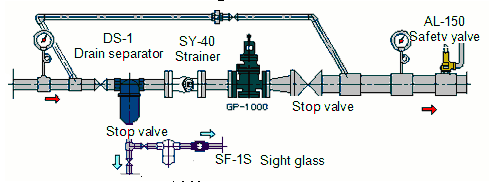For Steam System : Pressure Reducing Valve in Steam System
In the installation of pressure reducing valves in a steam system, it is necessary to consider sufficiently about the various valves and piping around the pressure reducing valve. It becomes an important point in quality, productivity, and energy saving.
With taking advantage of the use and effect of pressure reduction, it is necessary to perform installation with higher reliability and higher controllability.
- 1. For pressure reducing valve, largeness does not cover smallness. Too large pressure reducing valve has short service life, and in this condition secondary pressure may rise when no load. The size of a pressure reducing valve, and piping diameter of inlet side and outlet side are respectively different. Especially the piping diameter of outlet side has to be mach larger than size of pressure reducing valve, and be able to cover sufficient flow.
When load fluctuation is large, it is effective to install pressure reducing valves in parallel. - A strainer certainly has to be installed in front of a pressure reducing valve, and the screen should remove foreign substances in 60-100 meshes. "mesh" is an unit to show the size of meshes and expresses the number of mesh in 25.4mm (1 inch). (Example: if there are 20 numbers of mesh, "20 meshes.") The larger the numbers, the finer the meshes. Moreover, strainer can prevent condensate retention by attached sideways.
- Installation of a drain separator not only makes quality steam to be used but prevents erosion by condensate for the valve seat of pressure reducing valve.
- Install a bypass line for service use. About half size of the piping diameter of inlet side is suitable.
- As stop valves at inlet and outlet sides of pressure reducing valve, gate valve with little resistance is suitable. When a globe valve is used for stop valve of the inlet side, please attach it sideways.
- From view of equipment protection and safety, a safety valve must be attached at the outlet side of a pressure reducing valve for alarm use. The size should be what can obtain the amount of blow off about 10% of the maximum flow rate of pressure reducing valve.
- The pressure gauge is required for setup of outlet side pressure, and its maximum scale should be more than the twice of set pressure.
- Pressure reducing valve should be installed as near the steam use equipments as possible. By this, the effect of reduced pressure can be used to the utmost, and thick piping after a pressure reducing valve can be shortened more.
External Detection Type (Diaphragm Type)
By adopting a diaphragm with a large taking pressure area as a main valve controlling part instead of a piston, it can react to a slight change of outlet side pressure sensitively.
Moreover, with the external detection system, highly precise pressure reducing is possible by exact perception of the outlet side pressure without influence of steam turbulence.
Due to high Cv value and outstanding controllability, this type is the most appropriate when more precise pressure reduction is necessary.
Moreover, with the original diaphragm case structure, great durability is realized by distributing equally the stress added to the diaphragm.

Internal Detection Type (Piston Type)
The most typical pressure reducing valve for steam is GP-1000 series.
Since it is the internal detection type which has the outlet side pressure sensing hole inside of the main body, piping work is easy.
Moreover, by adoption of the piston which holds the stable operation realized by two-points guide structure for a long period of time, flexibility is high, and it can be used for almost all uses as a pressure reducing valve for steam of 1.0 MPa or less.
